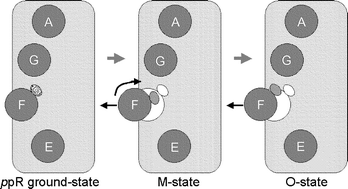Pharaonis phoborhodopsin (ppR) is a photosensor of negative phototaxis in Natronomonas (Natronobacterium) pharaonis, an alkalophilic halophile. This protein has seven transmembrane helices into which a chromophore, all-trans retinal, binds to a specific lysine residue (located in helix G)
via a protonated Schiff base. Various mutants were engineered to have a single cysteine in the F-helix. In the presence of a bulky fluorescent SH-reagent, MIANS, (2-(4′-maleimidylanilino)naphthalene-6-sulfonic acid, illumination decreased the photoreactivity or flash-yield (absorbance deflection immediately after the flash) of the L163C ppR mutant (in which Leu-163 was replaced with Cys) without changing the photocycling rate. The fluorescence of the isolated protein increased with increasing illumination. These observations suggest that during photocycling, the space around Cys-163 in the F-helix might open, permitting reaction with the relatively large molecule. This reaction occurred only at the M-state and not at the O-state. The implications are discussed.

You have access to this article
 Please wait while we load your content...
Something went wrong. Try again?
Please wait while we load your content...
Something went wrong. Try again?


 Please wait while we load your content...
Please wait while we load your content...